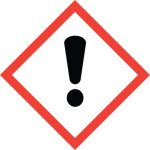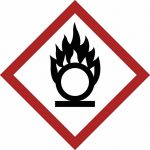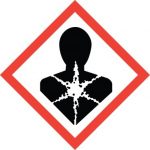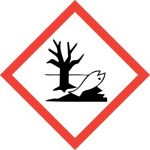1. PRODUCT IDENTIFICATION
Name: Thorium Perchlorate, 99%
Formula: Th(ClO4)4
Supplier
IBI Labs
3495 N. Dixie Hwy. Unit # 8
Boca Raton, FL 33431
Tel: 561-826-0061 Fax: 561-892-8450
Emergency Telephone Numbers
INFOTRAC
USA & Canada contact number: 1-800-535-5053
International contact number: 1-352-323-3500
2. HAZARD IDENTIFICATION
Classification of the Substance or Mixture
GHS Classification per 29 CFR 1910 (OSHA HCS)
Oxidizing solids (Category 2), H272
Acute toxicity, Oral (Category 4), H302
Skin irritation (Category 2), H315
Eye irritation (Category 2A), H319
Specific target organ toxicity – single exposure (Category 3), Respiratory system, H335
Specific target organ toxicity – repeated exposure (Category 2), H373
Acute aquatic toxicity (Category 2), H401
Chronic aquatic toxicity (Category 2), H411
GHS Label Elements, Including Precautionary Statements
Pictogram
Signal word: Danger.
Hazard Statements
H272 May intensify fire and oxidizer.
H302 Harmful if swallowed.
H315 Causes skin irritation.
H319 Causes serious eye irritation.
H335 May cause respiratory irritation.
H373 May cause damage to organs through prolonged or repeated exposure.
H411 Toxic to aquatic life with long-lasting effects.
Precautionary Statements
P210 Keep away from heat.
P220 Keep/Store away from clothing/combustible materials.
P221 Take any precautions to avoid mixing with combustibles.
P260 Do not breathe dust/fume/gas/mist/vapors/spray.
P264 Wash skin thoroughly after handling.
P270 Do not eat, drink, or smoke when using this product.
P271 Use only outdoors or in a well-ventilated area.
P273 Avoid release to the environment.
P280 Wear protective gloves/protective clothing/eye protection/face protection.
P301 + P312 IF SWALLOWED: Call a POISON CENTER or doctor/ physician if you feel unwell.
P302 + P352 IF ON SKIN: Wash with plenty of soap and water.
P304 + P340 IF INHALED: Remove victim to fresh air and keep at rest in a position comfortable for breathing.
P305 + P351 + P338 IF IN EYES: Rinse cautiously with water for several minutes. Remove contact lenses, if present, and easy to do. Continue rinsing.
P314 Get medical advice/attention if you feel unwell.
P321 Specific treatment (see supplemental first aid instructions on this label).
P330 Rinse mouth.
P332 + P313 If skin irritation occurs: Get medical advice/attention.
P337 + P313 If eye irritation persists: Get medical advice/attention.
P362 Take off contaminated clothing and wash before reuse.
P370 + P378 In case of fire: Use dry sand, dry chemical, or alcohol-resistant foam for extinction.
P391 Collect spillage.
P403 + P233 Store in a well-ventilated place. Keep the container tightly closed.
P405 Store locked up.
P501 Dispose of contents/container to an approved waste disposal plant.
Hazards not otherwise classified (HNOC) or not covered by GHS:
Radioactive.
3. COMPOSITION AND INFORMATION ON INGREDIENTS, PHYSICAL AND CHEMICAL PROPERTIES
Product Number: 12300
CAS RN: [16045-17-3]
Chemical Family: Metal perchlorate salt
Properties
- Molecular Formula: Cl4O16Th
- Molecular Weight: 629.839
- Appearance: White powder
- Solubility: Very soluble in water
- Melting Point, °C: ~355 decomposes to ThO2°C
- Boiling Point, °C: Decomposes
- Oxidizing Properties: The substance is classified as oxidizing.
4. HAZARDS IDENTIFICATION
Emergency Overview:
- Irritating to eyes, skin, and respiratory tract.
- It may be harmful if swallowed.
- It may affect thyroid and kidney functions.
Primary Routes of Exposure: Ingestion
Eye Contact: Causes moderate irritation of the eyes.
Skin Contact: Causes moderate irritation of the skin.
Inhalation: Irritating to the nose, mucous membranes, and respiratory tract.
Ingestion:
- No specific information is available on the physiological effects of ingestion.
- It may cause gastrointestinal irritation, nausea, and vomiting.
Acute health effects: Irritating to skin, eyes, and respiratory tract.
Chronic health effects: Perchlorates reversibly inhibit thyroid iodine uptake. Kidney function may be affected.
NTP: NO
IARC: NO
OSHA: NO
5. FIRST AID MEASURES
General advice: Consult a physician, show this safety data sheet to the doctor in attendance, and move out of a dangerous area.
Eye exposure:
- Immediately flush the eyes with copious amounts of water for at least 10-15 minutes.
- A patient may need assistance in keeping their eyelids open.
Skin exposure:
- Wash the affected area with water.
- Remove contaminated clothes if necessary.
- Seek medical assistance if irritation persists.
Inhalation:
- Remove the patient to fresh air.
- Monitor the patient closely for signs of respiratory problems, such as difficulty breathing, coughing, wheezing, or pain. In such cases, seek immediate medical assistance.
Ingestion:
- Keep the patient calm.
- Give the patient water (only if conscious).
- Induce vomiting only if directed by medical personnel.
6. FIREFIGHTING MEASURES
Extinguishing medium: Carbon dioxide or dry powder.
Special firefighting procedures:
- Spray closed containers with water until the fire is out.
- Avoid contact with combustible material.
- Firefighters should be equipped with a NIOSH-approved self-contained breathing apparatus.
Hazardous combustion and decomposition products: If involved in a fire, this material may emit corrosive hydrogen chloride fumes.
Unusual fire or explosion hazards:
- Releases oxygen on heating.
- May decompose explosively under firefighting conditions.
- Do not mix with combustibles.
7. ACCIDENTAL RELEASE MEASURES
Personal precautions, protective equipment, and emergency procedures:
- Use personal protective equipment.
- Avoid dust formation.
- Avoid breathing vapors, mist, or gas.
- Ensure adequate ventilation.
- Evacuate personnel to safe areas.
- Avoid breathing dust.
- For personal protection see section 8.
Environmental precautions:
- Prevent further leakage or spillage if safe.
- Do not let the product enter drains.
- Discharge into the environment must be avoided.
Methods and materials for containment and cleaning up:
- Sweep up and shovel.
- Contain spillage, collect it with an electrically protected vacuum cleaner or by wet brushing, and place it in a container for disposal according to local regulations (see section 12).
- Keep in suitable, closed containers for disposal.
8. HANDLING AND STORAGE
Conditions for safe storage, including any incompatibilities: Store in a tightly sealed container in a cool dry place away from combustible and flammable materials. If the container is left open, salt may adsorb water from the atmosphere.
Precautions for safe handling:
- Avoid contact with skin and eyes and the formation of dust and aerosols.
- Provide appropriate exhaust ventilation at places where dust is formed.
- Keep away from sources of ignition.
- Keep away from heat and sources of ignition.
9. EXPOSURE CONTROLS AND PERSONAL PROTECTION
Eye protection: Always wear approved safety glasses when handling a chemical substance in the laboratory.
Skin protection: Wear protective clothing and gloves.
Ventilation: If possible, handle the material in an efficient fume hood.
Respirator: If ventilation is not available a respirator should be worn. The use of respirators requires a Respirator Protection Program must follow 29 CFR 1910.134.
At any detectable concentration: Any self-contained breathing apparatus with a full facepiece operated in a pressure-demand or other positive-pressure mode.
Any supplied-air respirator with a full facepiece operated in a pressure-demand or other positive-pressure mode or other positive-pressure mode with an auxiliary self-contained breathing apparatus operated in pressure-demand or other positive-pressure mode.
Escape – any air-purifying, full-facepiece respirator with a high-efficiency particulate filler.
Any appropriate escape-type, self-contained breathing apparatus.
Clothing: Employees handling radioactive substances should wear disposable overgarments, including head and foot coverings. These garments are also recommended even if the employee uses a “glove box” containment system. Certain clothing fibers may be useful in dosimetry so clothing should be kept.
Gloves: The selection of appropriate gloves depends on the material, while the quality standards may vary among manufacturers.
Firefighting and Other Immediately Dangerous to Life or Health Conditions
Use any self-contained breathing apparatus with a full facepiece respirator and a high-efficiency particulate filter.
Use any supplied air respirator with a full facepiece operated in a pressure-demand or other positive-pressure mode or other positive-pressure modes with an auxiliary self-contained breathing apparatus operated in pressure-demand or other positive-pressure modes.
10. STABILITY AND REACTIVITY
Stability: Hygroscopic.
Hazardous polymerization: No hazardous polymerization.
Conditions to avoid: Any contact with combustible matter.
Incompatibility: Reducing agents, organic matter, active metals, phosphorus, sulfur, hydrazine, hydroxylamine, and strong acids.
Decomposition products: Oxygen, Sodium oxide, hydrogen chloride.
11. TOXICOLOGICAL AND ECOLOGICAL INFORMATION
RTECS Data: Intraperitoneal (mouse); LD50: 1150 mg/kg.
Carcinogenic Effects: No data available.
Mutagenic Effects: No data available.
Tetratogenic Effects: No data available.
Ecological Information: No data available.
12. DISPOSAL CONSIDERATIONS
Disposal: Dispose of it according to local, state, and federal regulations.
Waste Treatment Methods
Product: Contact a licensed professional waste disposal service to dispose of this material. After use follow local procedures for radioactive waste. Consult local, state, and federal regulations on the disposal of radioactive waste. Observe all federal, state, and local environmental regulations.
Waste from residues/unused products: Waste disposal must follow appropriate Federal, State, and local regulations. If unaltered, this product may be disposed of by treatment at a permitted facility or as advised by your local hazardous waste regulatory authority. Residue from fires extinguished with this material may be dangerous.
Contaminated packaging: Do not reuse empty containers and dispose of them as unused products.
Recommendations: Should not be disposed of with household garbage.
13. TRANSPORTATION
Shipping Name (CFR): Thorium perchlorate.
Hazard Class (CFR): 5.1
Additional Hazard Class (CFR): NA
Shipping Name (IATA): Thorium perchlorate
Hazard Class (IATA): 5.1
Additional Hazard Class (IATA): NA
The U.S. Department of Transportation (D.O.T.) Code of Federal Regulations (49 CFR Parts 100-185), the International Air Transportation Association (IATA), the International Civil Aviation Organization (ICAO), and the International Maritime Organization (IMDG) are all factored into the classification and transport of material.
Proper Shipping Name:
UN/ID Number: To be determined on a case-by-case basis.
Special Information:
Packing Group
The classification of substances with multiple hazards must be determined following the criteria presented in the regulations mentioned above. Due to the various quantities and combinations of materials being shipped at one time, the information above must be determined based on the characteristics of the specific shipment.
13. REGULATORY INFORMATION
TSCA: Not listed in the TSCA inventory.
SARA (Title 313): Title compound not listed.
Second Ingredient: None
Third Ingredient: None
14. OTHER INFORMATION
Copyright 2014 IBI Labs. License granted to make unlimited paper copies for internal use only.
IBI Labs requires that those who receive their materials comply with 29 CFR 1910.1200(h), which mandates that employers provide employees with effective information and training about hazardous chemicals in their workplace.
The contents of this document are believed to be accurate as of the date of revision and are provided in good faith. However, it is recommended that recipients use this information as supplementary and exercise caution and judgment regarding its accuracy and suitability. Please note that IBI Labs cannot be held responsible for any damage, direct or indirect, that occurs because of using the information provided in this Safety Data Sheet.
IBI Labs makes no warranties, expressed or implied, including warranties of merchantability and fitness for a particular purpose. This information is provided without warranty, and any use of the product that does not conform to this Safety Data Sheet, or that is used in combination with any other product or process, is the user’s responsibility.
Revision Date: 10/23/2024





